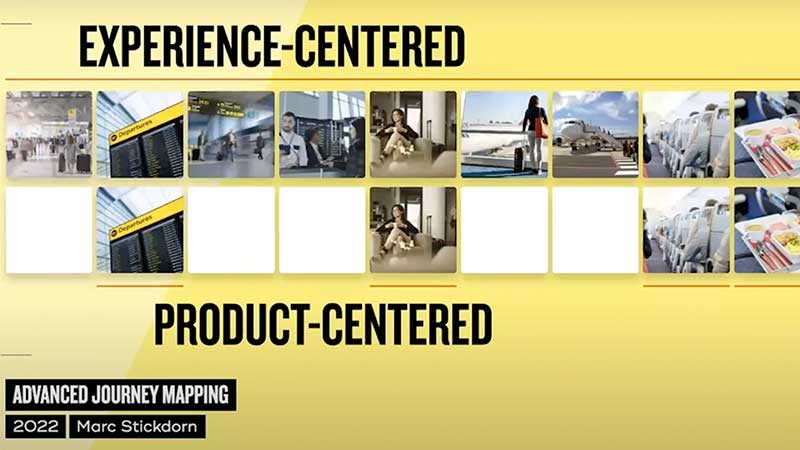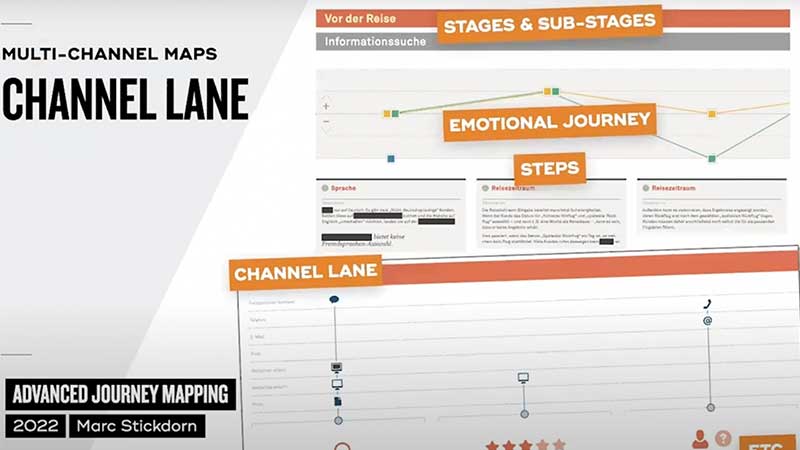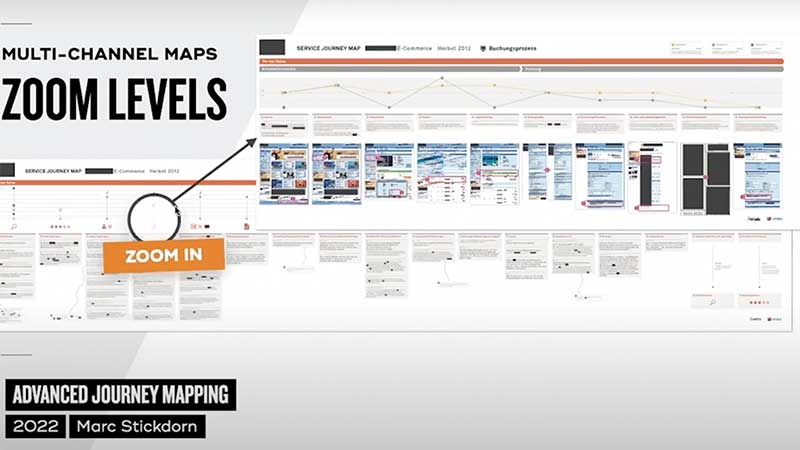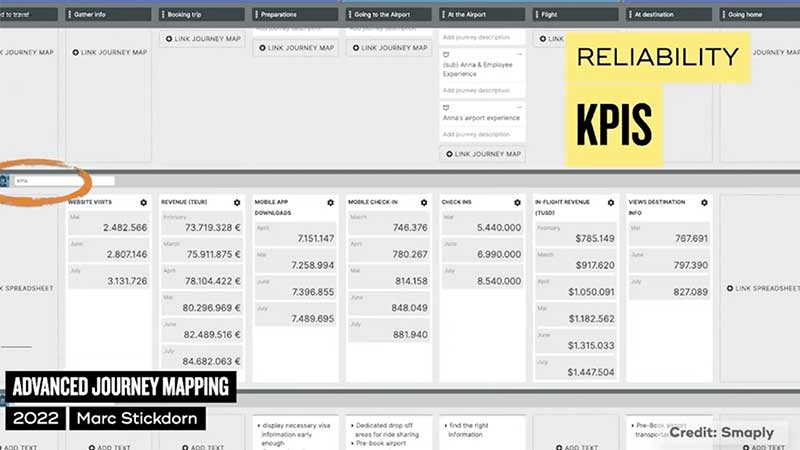Ask Marc – about managing CX across online and offline channels
In this webinar, we talked about how to manage customer experience across online and offline channels. The main question was what the challenge of omnichannel customer experience management is. Furthermore, we looked into the details of how you can research experiences beyond digital analytics. Also we will look into why qualitative data is so important and how you can manage experiences if they happen out of your reach.
This series was initiated as a place for you to learn more about service design and journey mapping software. Our co-founder Marc Stickdorn and the Smaply team share their experience on how to embed and scale service design in organizations. The sessions usually kick off with a short introduction to the focus topic to bring everybody to the same page, followed by your questions and deep discussions of best practice examples.
On this page you find the recording as well as the transcript. Additionally this session is also available as a podcast on Spotify, iTunes and Google Podcasts.
Overview
[02:30] How can you visualize customer experience if it is a cross-channel experience?
[06:05] Should you use qualitative or quantitative data?
[15:30] What are examples of offline channels that are worth having a closer look at?
[16:40] How can we gather information about these offline experiences?
[21:10] To what degree do I need to collect data for channel performance before I can start mapping?
[22:30] What are some KPIs of offline experiences that might be relevant?
[24:25] What should I focus on when creating personas for my channel map?
How can you visualize customer experience if it is a cross-channel experience?
Marc: If you think of a journey map, it usually shows one experience. But it's up to you to add more data to it. What you see in this example is different lanes – you have a storyboard on top, then the emotional journey, and then you have a channel lane. A channel overview looks like a swim lane map.
From above you see which channels are involved. You can use it for two different purposes: on the one hand you can use it as an overview to get an idea, i.e. what are the channels that we have available as an organization to get in touch with customers? But you can also highlight the preference.
If you for example have one particular persona, you can visualize the preferences for each step of the journey. You can also see where the experience crosses the channels. Then, if you combine a channel lane with a text lane below, you can add further information regarding this channel to it. You can either add it directly to the channel lane, or you can think about adding pain points and channel specific pain points.
Perhaps you can compare the experience from one channel to another.
Or you can detail out what kind of channel we have specifically. Is it a one-way communication or two-way communication? You can add information regarding what can possibly go wrong. Also that can be channel specific, and of course a whole bunch of research data that you can also add channel specifically to it.

How can you use a tool like a journey map to compare different experiences if they are cross-channel?
Marc: You can add multiple journeys on one journey map. In this example you can show how the experience differs when people use different channels. If someone uses a check-in on their mobile phone, compared with a check-in on the website, compared with the check-in at the airport – different journeys.
They might be the same before and afterwards, but in some areas, when you choose different channels, they might differ. You can learn from them; what works well in one channel, what doesn’t work in another. Perhaps you get some ideas from the good examples.

Think about adding real customer data to it, real proper research that you've done. Usually we do research channel-specific, however there are a few research methods that you can use that also work across channels.
Think about any kind of self-documentation, research about mobile ethnography, diary studies, shadowing.
Anything where you follow customers throughout the experience. These kinds of research approaches help you to understand where people cross channels and why.
It's really hard to understand what drives people to move to another channel at a certain point.
Should you use qualitative or quantitative data?
Marc: Both, of course. Especially if we want to understand the cross-channel experience. It's important to compare the experience and compare the performance of the different channels as well.
You can add multiple journeys to a journey map. In an earlier session we already talked about this repository of maps – journey map operations. To operationalize the whole repository, to add live data to it etc.
You can also add a layer of channels where you can filter for channels, think about adding tags for example. You can look for channel specific pain points and stuff like that.
Something else you can do is define the vision experience per channel. Where do you want to go? What is the future state experience that you're designing towards, and what is the current state experience? That also works brilliantly on one channel, but it's important to understand at what point we want to nudge people into a different channel.
So if your numbers tell you that the experience is better on a particular channel, you can think and start to plan ahead how you can nudge people towards that specific channel.
And now we’ll briefly talk about the difference between experience-centered journeys and product-centered journeys. This is particularly of interest if you think about cross-channel experiences.
The experience of a customer at an airport is particularly interesting when considering cross-channel: now the check-in is done on the mobile phone, perhaps there are other steps where they check the website on the phone in between, they have maybe
printed the documents. When checking in their bags they get a baggage receipt, etc. If you look at these experiences through the perspective of an airline, and you only see those steps that are under the airlines control, you see a very fragmented picture.

“The rest, that's out of scope, I can't influence it. I can't design it, it’s out of my control, therefore I don't need to include it in my journey.”
That’s not true. You need to, because it's driving the entire experience. Even if you don't have it under control, you can check the steps before it. How can I reach customers, how can I prepare them for a certain experience? You can still influence these steps. I would like to tell you a quick story about this and why it's important to know for each step on which channel it occurs.
There was an airport which had a problem with their security checks. At one terminal people consistently missed their flights because of the queues at the airport, the infrastructure was just overloaded. They couldn't keep up anymore.
People stood in line for too long, causing a lot of stress for the passengers and of course resulting in stress for the employees as well. If you look at that perspective from the airline, you say well the security check that's out of scope, I can't change it. It's the fault of the airport. Then the blame game starts.
But what this airline actually did is they looked at their different channels, how they can reach customers and how they might be able to influence the experience.
In the end, during the check-in they informed the customer about the high traffic at the security check in this terminal and suggested walking to another terminal. They had to walk 15 minutes to the terminal where they could enter without a queue, and then they needed to walk back. They made their flight.
Even if they couldn't influence it directly, by understanding on which channels they could reach their customers and how they can bring information across for them, they could influence this step. Even out of their range. That's why it's important to understand the entire experience, and not only your own touch points.

Marc: Here you see a channel lane with the different channels per step. There were two different zoom levels. You have the high level map with the channel overview and we can zoom in, not only on one particular step, but one particular channel on a step. We then created detailed maps for the particular experience on one channel.
Then we compared the experience on the different channels. In this case it was the booking process: we compared online, booking by telephone and booking in shops. With a map like that you get an overview, and then you can zoom in. There are different things you can do.
On the overview map, there are usually no personas, but in the detailed map you then get more granularity, perhaps on different channel preferences and where they switched channels.
Nicole: This is completely off topic but I'm sharing it because it's lovely. At the Calgary airport in Canada when it gets insane behind the gates because of delayed flights they call in the people with the emotional support dogs. It calms everyone down, and everyone gets doggy snuggles before they get on their plane. So, a very innovative solution to a nasty problem.
I did a project quite early in my service design career. The organization - very much a marketing led organization - had tons of data, they had lots of customer understanding from a demographic point of view. They had a really reactive UX team whose job was to simply put into place what they were told to do.
They weren't really able to be strategic. And then they were asked to figure out how they could leverage the digital channel to bring together all of their other siloed channels. All of a sudden they were sitting in strategy land, bringing everyone together.
It was really fascinating to talk to people about the whole experience. We were able to understand how people's behaviors at different moments in time, depending on what's going on in their lives, drives them to use different channels.
The most interesting thing that came out of that work was a realization that they had built their digital channel to serve a very specific customer type.
The challenges with that channel were actually driving that whole group of users to one of their offline channels, while attracting people to their online channels that they preferred to use their offline channels. They wouldn't have really figured that out if it weren't for looking at it all as a holistic end-to-end experience, understanding from a human point of view.
When do you use one versus the other? What's happening for you? What value are you getting out of them?
And it was incredibly powerful. It really led to an entire culture shift to starting to use behavioral persona, qualitative data on top of all that marketing data.
What are examples of offline channels that are worth having a closer look at?
Nicole: I'll say that there they had a digital channel, and then they had bricks and mortar.
Things existed in the real world, but in really different ways. They had channels that existed in convenience stores and gas stations, there were kiosks in malls, they had their own properties that offered different services. Probably about four different bricks and mortar channels that offered really different things.
It was interesting because a lot of the same people would use those different channels, but for different reasons. And it was understanding how they linked together for people that was really insightful.

How can we gather information about these offline experiences?
Nicole: We went to malls and did intercepts. We recruited online to talk to people who frequented some of the convenience store channels, where people are in and out and the intercepts are a bit harder because people are in a rush.
We did telephone interviews with those people because there were a lot of them. I think we did about 75 of them and then for these bigger properties we did intercepts as well, but we went and spent the whole day at these properties and just talked to people. We spent more time with them. People at those properties were generally there for a longer period of time, so they were willing to give us more time. We could go a lot deeper with them and have them show us what they were doing, talk about their lives.
And then we also recruited people and went and visited them in their homes and did face-to-face interviews with them there and that's where we were able to talk about how they use the online channel and how that interacts with other channels that are available to them.
Marc: It’s a thing that companies sometimes are not even aware of all the channels they're offering because sometimes a customer receives information through a third party, or maybe not directly, but indirectly. And they're not aware of it.
Why should I care about the time that people spend elsewhere than my own pages and not only optimize that?
Marc: I was working once with a manufacturer of saunas and they were selling the stuff in their own shops. They had construction stores, and online shops, trade shows and all these traditional sales channels. On top of that they had the classic communication channels: ads, print ads, TV ads and similar. They were pretty good at measuring the channels they had under control.
Although they didn't think much about how people cross channels and so on. When we started working with them and doing research, we realized that once we started mapping the journey and adding the layer of channels to it, that there was a consistent pattern among the buyers. Every interview they told us about their first contact in a hotel. It was always just a side sentence, until we realized that one of their customers were hotels and hotel chains, who used their product.
Nobody ever thought this to be one of the biggest multipliers they had.
Hotel guests used a product there and through this product they got interested in that. Only then did they actually get in touch with the hotel.
The journey was longer than they thought, they expected they might have come through our advertisements, but once they were in the shop or once they bought online they didn't think about where they actually came from.
If you extend the journey and try to understand what happens outside of your channels it also helps you to optimize the existing channels.
Because then you can place messages there, you can partner with them. In the end they added brochures there, nudging people to move to the online channel to learn more. Because they were aware of this they then proactively also announced this. They gave people a chance to try out their product while also advertising for the hotel, again nudging people to different channels for different purposes.
To what degree do I need to collect data for channel performance before I can start mapping?
Nicole: I say none. Many organizations have no data when they start doing this work.
Marc: Journey mapping is a great way to become aware of the gaps in data that you have. You might start assumption-based. Start with “We think this is our customer’s experience” and then you need to validate it. We can't make decisions on assumption-based journey maps.
A great starting point is to start collecting data, and aim at collecting data for every step.
Also you can use it to create an inventory, even if you say we don't have any data, I bet you have data. The thing is that you're not aware of it because it's somewhere in another place in the organization. The journey map acts as a great boundary object, helping you to connect all the different pieces and visualize what you got.
What are some KPIs of offline experiences that might be relevant?
Marc: On the one hand you can use similar KPIs like we use in online settings. One of the core things we do online is stuff like a conversion analysis.
The conversion analysis is your conversion funnel, it just means you track how many people make it from one step to the next step of the journey and so on.
It's pretty easy to do this online, but you can do the same thing offline. You can keep track of how many people enter your store. In a B2B context the question is more on how many contacts you had at a trade show.

Think about the next step of the journey, you can rebuild this. And by that you can also compare the performance of different channels. Experience KPIs work the same way online and offline. I'm not gonna get into a rant about Net Promoter Score, but you can ask similar questions about the experience, no matter which channel you do it.
I mean we see it increasingly in bathrooms, where you have the little smiley buttons. It is one way to get this kind of feedback in public spaces.
What should I focus on when creating personas for my channel map?
Nicole: I think that there's a lot of things you can focus on when creating personas. I find in most of the work that I've done, I'll often call personas behavioral archetypes. So the key thing that's marking the difference in the persona is the behavioral mindset of the individuals, that seems to be a big qualitative feature that stands out in research.
That is a lot less likely to be captured by market research and data. So those behaviors and attitudes are one of the most critical things to look at for building out personas and differentiating personas from each other.

Marc: I would add behavior patterns when it comes to channel preferences, channel usage and specifically channel preferences in context. If people are at home they use different channels. If I'm at home and I want to find out information about a certain company, I probably get to my desk where I have my big screen, type it in there and go online at my desktop. If I'm on the go, I might do it on my phone. If I'm commuting, I might be standing in a bus or subway.
So the context is really important, if you think of the different context it also means when do you send certain messages. If you're aware of this and you know that conversion is better when people look at it on a big iPad or another big computer screen at home, then don't send the message during the work week in work times. Then people are probably just checking their emails on their mobile phone during the lunch break.
And now, what's next?
Check out the other Ask Marc sessions about different topics of human-centric work, like multi-persona maps, creating CX insight repositories, and many more.
Or get more insights specifically on designing experiences across channels.











